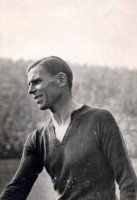

"a strong defence and a fast, counter-attacking response, with the focus on quick, short passing and mazy runs from his wingers, who would pass low inside the defence instead of crossing from the byline"
"Chapman bought perceptively, welded his assets together astutely and soon sent out one of the most successful League sides of all time (Huddersfield). It was stubborn, disciplined and highly mobile with Clem Stephenson, once of Aston Villa, at the heart of everything. He was a stocky tactician without much pace but his passes were as sweet as stolen kisses."
and at Huddersfield he saw no reason to change his mind. But in reality it was panic over loss of revenue. After an understandable surge following the end of the Great War crowds had been falling. The blame was put on reduction of action. It wasn't really true. It was simply different action. Defensive play improved as more teams learnt offside but at the same time those same teams were learning to beat it. The number of goals did fall, then settled and began to climb again but it didn't matter. The rule-change had been made. The number required for off-side was reduced from three to two. And it seemed to work. Huddersfield Town, now without Chapman, who had made the move to Arsenal, in winning the 1926 league, its third in succession, scored ninety goals and let in sixty having the previous year conceded just twenty-eight and netted just sixty. And then someone thought about it. The intellect was Charlie Buchan, even if the idea was not entirely original."a team can attack for too long"
